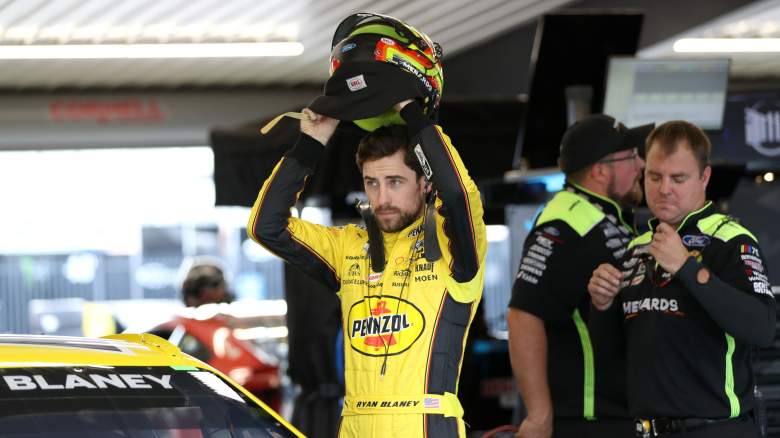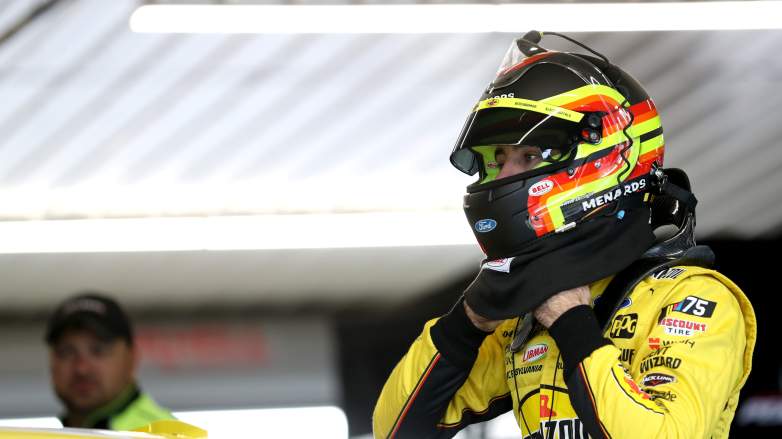
Getty Ryan Blaney expressed frustration after a crash at Nashville Superspeedway.
The Ally 400 Cup Series race at Nashville Superspeedway came to an early end for Ryan Blaney after a hard crash against the concrete wall. He avoided injury, but he expressed frustration with the absence of safety measures in one part of the track.
The incident occurred on a restart just after the halfway point of the race. William Byron hit Brad Keselowski from behind, who momentarily lost control and bunched up the field. Blaney checked up along with others in the field, but he went sliding through the grass after contact from Kyle Busch. The No. 12 Team Penske Ford then slammed head-on into the concrete wall at the end of pit road.
“I don’t really know what happened,” Blaney said after undergoing evaluation at the infield care center. “Someone checked up on the restart, I guess. I kind of checked up, got hit from behind — I didn’t know if they were wrecking — and I just couldn’t get it straightened out.
“When I got out of the grass, I thought I was going to come back around, and that I’d be ok. Just never got back right. I don’t know why there’s no SAFER barrier there. That’s pretty ridiculous, honestly. Hardest hit I’ve ever had in my life. Happy to be all right, but it sucks for the Pennzoil Ford Mustang. Stinks to go home early.”
The SAFER Barrier Plays an Important Role

GettyRyan Blaney prepares for practice at Nashville Superspeedway.
The SAFER (Steel And Foam Energy Reduction) Barrier is found at NASCAR tracks around the country. It consists of steel tubes welded together and pieces of polystyrene foam mounted behind them. This entire construction mounts to the existing concrete wall at the tracks.
The goal of the SAFER Barrier is for it to absorb the kinetic energy of the stock car hitting it at close to 200 mph. The energy is dissipated along the wall, which reduces the amount going into the car and the driver.
The SAFER Barrier covers the majority of areas at Nashville Superspeedway, but it is not present at the end of pit road where Blaney’s collision took place. Though that will potentially change ahead of the next race weekend at the Tennessee track.
“NASCAR safety engineers work closely with safety experts on the implementation of barriers around the track,” the sanctioning body said in a statement after the race. “As we do following every race weekend, we will evaluate all available data and make any necessary improvements.”
The Focus on Safety Will Continue
The trip to Nashville Superspeedway highlighted another area where NASCAR will need to focus ahead of the 2024 season. The SAFER Barrier will need to be put in more areas surrounding the 1.33-mile track to account for other crashes that could take place in the future.
“I hope he was okay — that’s the most important thing,” Brad Keselowski said in reference to Blaney’s crash at Nashville Superspeedway. “Sounds like more work to do there, too.”
There have been multiple occasions in the Next Gen era when safety has become a talking point. These discussions took place as drivers sustained concussions after contact with the outside wall, as well as after fires erupted in the Ford Mustangs.
The safety discussions also continued into 2023 after the trip to Talladega Superspeedway and a crash involving Kyle Larson and Ryan Preece.
Each time these discussions took place, NASCAR began making changes in the pursuit of improved safety. Some changes were faster while others took extra time. Now, there will likely be more after Blaney’s crash at Nashville Superspeedway.